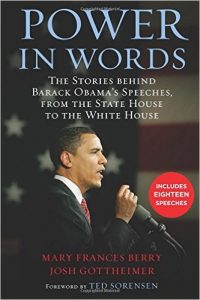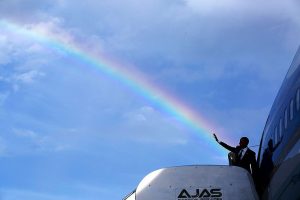 When a friend suggested I write a rainbow review of President Obama’s farewell speech, I took the excellent book Power in Words down from my bookshelf and flipped through the pages. Published in 2010, it has the speeches and the stories behind Barack Obama’s eighteen great speeches made before he was elected President in 2008. The introduction sets the tone, “It’s fair to say that when it comes to politics, there are few things Americans agree on. That said, there is one thing that is not debatable: Barack Obama can deliver one hell of a campaign speech.”
When a friend suggested I write a rainbow review of President Obama’s farewell speech, I took the excellent book Power in Words down from my bookshelf and flipped through the pages. Published in 2010, it has the speeches and the stories behind Barack Obama’s eighteen great speeches made before he was elected President in 2008. The introduction sets the tone, “It’s fair to say that when it comes to politics, there are few things Americans agree on. That said, there is one thing that is not debatable: Barack Obama can deliver one hell of a campaign speech.”
Eight years later, it is safe to say that, although American politics may be more divided than ever, Barack Obama can deliver one hell of a farewell speech too.
I knew before watching the full speech that I would see a rainbow because, as I told my friend, “Barack’s a rainbow kinda guy”. However, I got the wrong impression from the emotionally charged clips shown by TV news channels. And I was surprised that, although RED emotion is present, the real rainbow colors that dominate are GREEN, BLUE, and INDIGO. And President Obama blends those three colors so well during the long middle section of INDIGO, BLUE, and GREEN that they merge to form a unique and fascinating speech. Let me explain his use of each color….


Red Emotions: Red appears as the dominant color at the start of the speech. Red is sparked by the reference “so touched”, which leads into a story of his past in Chicago, the city where it all started. These red emotions spread through the crowd until they boil over and erupt in the chant, “four more years.” Red also shines at the end when he thanks his supporters, aides, family, and friends for their love and support. These two strong red sections balance the President’s green hope expressed at length during the middle of the speech.
Orange Energy: Speaking with presence and yet surprisingly low key, Obama balances the strong blues of his speech with the energy of the audience which he works to perfection. His choice of speaking in front of a partisan crowd of supporters, who repeatedly rise to their feet in applause, adds the necessary energy for him to pass a very deep green and blue message over this rather long speech. Only at the end does he feel a need to increase his vocal power to add an extra kick of energy to get his message across. For the most part the President relies on the power in his words and the crowd to give orange fuel to this speech.
Yellow Joy: Over the past eight years, Barack Obama has become a master of joyful banter and comedy, and yet he uses none of his skills here. Apart from the joy he displays when he walks on stage, this is not a demonstation of his sunny personality or humor. Only at the end, when speaking about the younger generation, does he let his optimism shine and a ray of joy enter into his speech – just enough to balance the purple moment which came immediately before. Yellow works to bookend this speech – at the opening and ending only.
Green Hope : The major part of his speech is a lesson to the American people and the world on Democracy. This is the statesman Obama speaking and delivering clearly a green message of hope in, and for, the future. In case you did not hear it, the last line of the speech is “Yes, we can.” The greatest green phrase in recent history and a sign that the future still needs this hopeful message.
Blue Vision: Addressing the crowd as it chants for four more years with a strong, “I can’t do that” signals Barak Obama’s entry into the blue vision of his speech. He follows this with “I still believe…” which starts his vision of the “American Idea.” However, as he extolls his vision of democracy and America he shifts to “we” instead of “I” giving his message a green color. A farewell speech which exhibits so little “I” is unusual. Barack Obama purposefully makes the American people the hero of his blue vision by using “We” instead of “I”. It is also interesting to note the excessive use of “If” – a signal of vision and hope. Lastly, the constant use of “We” instead of “I” has a second deeper meaning as the pronoun for the Obama husband and wife team who share the same vision.
Indigo Depth: The speech is structured around a clear theme when the President says, “That’s what I want to focus on tonight: the state of our democracy”. He announces three main threats to democracy yet speaks of four. And all have very deep Indigo meaning: providing economic opportunities; racial discrimination; loss of American values; citizens who take democracy for granted. Obama also uses the rule of three in his speech as a rhetorical device eg. “Show up, dive in, stay at it”. And his use of language is very Indigo as it ranges from the highly sophisticated words like “malevolent” to the colloquial, “I gotta move.” The richness of the President’s range of vocabulary speaks to all and delights the ear.
Purple Soul: The crowd and Obama are clearly connected from the start. He quickly establishes his purple vulnerabilty and how he will be walking the razor’s edge of improvisation with the expression, “I’m a lame duck. Nobody is following instructions.” This places him in the hands and hearts of the crowd. Furthermore, his reactions to the crowd’s interruptions show his ability to hear the soul cries of his supporters. When he announces the transfer of power to Donald Trump and hostility ripples through the crowd, his “No, No, No” is a majestic purple moment as he soothes the tension in the room. Lastly, the soul of Obama, the family man and friend, appears at the end when he speaks of Michelle, his daughers, and Joe Biden. The tear he sheds and emotions expressed by his long pauses and body language show him speaking with his purple soul.
Making his farewell address in Chicago, President Obama uses his incredible oratory skills and the power of words to launch a new campaign which begins in the home town of Michelle Obama. This is a speech which suggests that Barack Obama will work to be back at the Whitehouse for four more years as a citizen and husband. His farewell speech sets out the vision of democracy and America his wife, sitting in the audience, will stand for as candidate in 2020.
